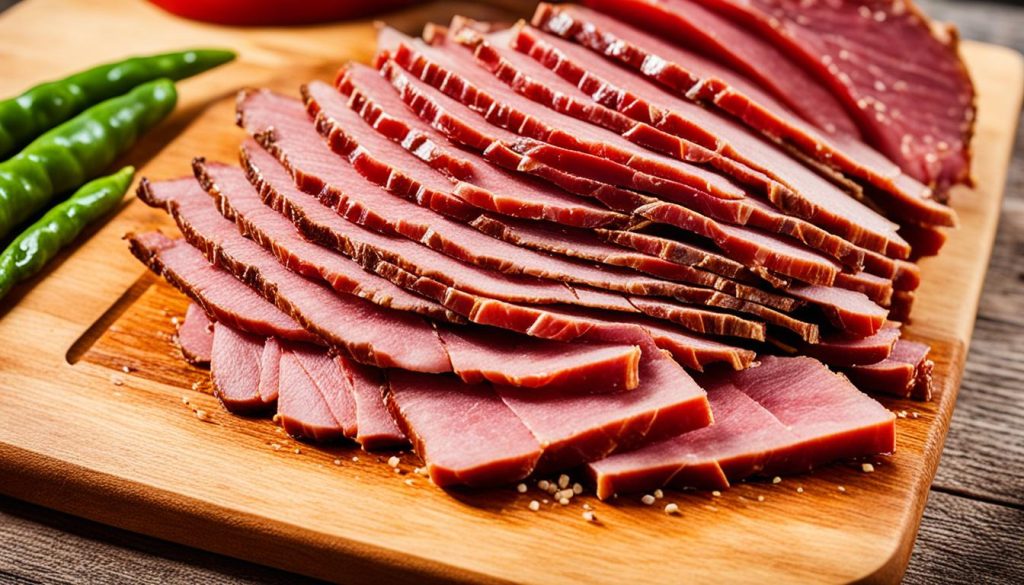Did you know that the practice of curing and smoking meat dates back thousands of years, making it one of the oldest forms of food preservation? This ancient technique not only extends the storage life of meats but also imparts rich flavors that tantalize our taste buds. Whether you’re a culinary enthusiast or simply looking to elevate your home-cooking game, understanding the art of salt curing and smoking meats is essential.
Key Takeaways:
- Salt curing and smoking meat is an ancient method of food preservation that enhances flavor and prolongs storage life.
- Proper curing techniques involve treating cuts of meat with a salt solution or dry salt to inhibit bacterial growth.
- Smoking meat adds a smoky flavor and preserves it through heat, antimicrobial compounds in smoke, and drying.
- Food safety considerations are crucial during the curing and smoking process to prevent foodborne illnesses.
- Choosing the right wood for smoking can greatly impact the flavor profile of the finished product.
The Art of Curing Meats
Curing meats with salt is an ancient process that has been practiced for centuries to preserve meat and enhance its flavor. This traditional skill involves drawing out moisture from the meat and creating an inhospitable environment for bacteria and fungi, extending its storage life.
There are two main methods of salt curing: brining and using dry salt. In the brining method, the meat is soaked in a saltwater solution called a brine, allowing the salt to penetrate the meat and break down its proteins, which helps to retain moisture during the cooking process. Dry salt curing, on the other hand, involves coating the meat with a mixture of salt and other seasonings, such as sugar, herbs, and spices. The salt draws out moisture from the meat, concentrating its flavors.
Curing salts are often used in the salt curing process to ensure food safety. These salts commonly contain sodium nitrate or sodium nitrite, which help prevent the growth of harmful bacteria, such as Clostridium botulinum. These curing agents give cured meats their distinctive pink color and also provide flavor and preservation benefits. However, it’s important to use curing salts in the correct amounts as excessive consumption of sodium nitrate or nitrite can be harmful to health.
Properly cured meats can have an extended storage life, making them ideal for long-term preservation. When stored under the right conditions, such as cool temperatures and low humidity, salt-cured meats can last for months, allowing for a steady supply of delicious cured meats without the need for refrigeration.
Looking to enhance the flavor of your homemade cured meats even further? Consider experimenting with different herbs, spices, and seasonings to create unique flavor profiles. The art of curing meats offers endless possibilities for creating culinary masterpieces that showcase your creativity and expertise.
| Benefits of Salt Curing Meats | What You Need |
|---|---|
|
|
If you’re interested in mastering the art of curing meats, it’s essential to learn proper techniques and acquire the necessary skills. Online resources, books, and traditional workshops can provide valuable guidance in understanding the science behind curing and mastering the techniques involved.
In conclusion, salt curing is a time-honored method of meat preservation that not only extends the storage life of meats but also enhances their flavors. With the right knowledge and traditional skills, you can embark on a journey of creating your own delicious cured meats that will impress your family and friends.
Smoked Meat: Techniques and Methods
Smoking meat is a time-honored culinary practice that adds a unique flavor and aroma to various cuts of meat. By exposing the meat to smoke produced by hardwood or fruitwood chips, different smoking methods can be used to achieve the desired results. This section will explore two main smoking methods: hot smoking and cold smoking, and provide recipe ideas for flavor enhancement.
Hot Smoking
Hot smoking is a method that combines heat and smoke to cook the meat thoroughly while infusing it with a smoky flavor. To hot smoke meat, you will need a smoker or grill set up for indirect heat. The temperature usually ranges between 225°F and 275°F (107°C and 135°C). Hardwoods like hickory, mesquite, and oak are commonly used for hot smoking due to their robust flavors.
During the hot smoking process, the meat is cooked slowly over several hours until it reaches a safe internal temperature. This technique enhances the flavor and tenderness of the meat, creating a delicious smoky crust on the surface. Hot smoking is ideal for cooking larger cuts of meat, such as brisket, ribs, or whole chickens. The end result is juicy, flavorful meat that is perfect for a hearty barbecue feast.
Cold Smoking
Cold smoking, on the other hand, is a method used to flavor and preserve meats without actually cooking them. It is typically done at temperatures below 100°F (38°C) and requires specialized equipment like a cold smoker or smoke generator. Cold smoking is a gradual process that can take anywhere from a few hours to several days.
The purpose of cold smoking is to add a delicate smoky flavor and dehydrate the meat, making it perfect for applications like charcuterie or smoked salmon. To cold smoke, it is important to use hardwood or fruitwood known for their mild flavors, such as apple, cherry, or alder wood. These woods provide a gentle smokiness that complements the natural flavors of the meat without overpowering them.
Recipe Ideas for Flavor Enhancement
- Smoked Pork Ribs with a Sweet and Smoky BBQ Sauce
- Smoked Beef Brisket with a Texas-style Dry Rub
- Smoked Salmon with a Citrus and Dill Marinade
- Smoked Chicken Wings with a Spicy Chipotle Glaze
- Smoked Vegetables with a Herb-infused Olive Oil
These are just a few examples of the endless possibilities for flavor enhancement through smoking. Experiment with different types of meat, seasonings, and wood combinations to create your own unique smoked dishes. The key is to balance the flavors of the meat with the smokiness provided by the chosen wood.
Now that you have an understanding of the smoking methods and recipe ideas, let’s explore the importance of food safety considerations when it comes to curing and smoking meats.
Food Safety Considerations
Proper food safety practices are essential when it comes to curing and smoking meats. To ensure the safety and quality of your homemade smoked meats, there are a few key considerations to keep in mind.
Starting with Fresh Meats
Before you begin the curing and smoking process, it is crucial to start with fresh, high-quality meats. Inspect the meat carefully, looking for any signs of spoilage or contamination. Choose cuts of meat that are well within their expiration date to minimize the risk of foodborne illnesses.
Using the Right Type and Amount of Salt
The type and amount of salt used in the curing process are vital to achieve effective preservation. Depending on the meat and curing method, different salts may be used, such as kosher salt or curing salts containing nitrate or nitrite. It is crucial to follow recommended measurements and guidelines to ensure food safety and proper curing.
Consider Nitrate and Nitrite Usage
When it comes to curing meat, the use of nitrate and nitrite can be a topic of debate. While they play a vital role in preventing the growth of harmful bacteria, excessive consumption may have health implications. It is essential to carefully consider the use of nitrate and nitrite, following recommended guidelines and consulting reputable sources.
Maintaining Correct Temperatures and Times
During the smoking process, it is crucial to maintain correct temperatures and times to eliminate any potential pathogens or parasites. Smoking meats at the right temperature not only imparts flavor but also ensures the meat reaches a safe internal temperature. Always follow recommended smoking guidelines to minimize the risk of foodborne illnesses.
| Food Safety Tips | Key Points |
|---|---|
| Start with fresh meats | Inspect for spoilage or contamination |
| Use the right type and amount of salt | Follow recommended measurements and guidelines |
| Consider nitrate and nitrite usage | Consult reputable sources for proper usage |
| Maintain correct temperatures and times | Ensure meat reaches a safe internal temperature |
Adhering to these food safety considerations can help ensure the safety and quality of your cured and smoked meats. By following proper practices and guidelines, you can enjoy delicious homemade smoked meats while minimizing the risk of foodborne illnesses.
Choosing the Right Wood for Smoking
The flavor of smoked meats is greatly influenced by the type of wood used during the smoking process. Different woods, such as hardwood and fruitwood, can impart unique flavors to the meats, enhancing the overall taste and aroma.
Popular hardwoods like apple, hickory, maple, and mesquite are frequently used for smoking due to their rich flavors and aromas. Each wood variety adds its own distinct character to the meat, allowing for a diverse range of flavor profiles.
On the other hand, it is important to avoid using toxic woods or resinous woods that can result in a bitter taste. Be sure to choose woods specifically designated for smoking to ensure optimal flavor enhancement.
The selection of the right wood for smoking is crucial in achieving the desired outcome. Whether you prefer a subtle hint of fruity sweetness or a robust smoky flavor, choose the wood that complements your taste preferences and the type of meat you’re smoking.
For more information on smoking methods and hardwood selection, visit Smokehouse Products.
Conclusion
Salt curing smoking meats is an ancient technique that not only enhances the flavor but also extends the storage life of meats. By mastering the traditional skills of proper curing and smoking techniques, individuals can create their own homemade smoked meats with unique flavors and textures.
However, it is essential to prioritize food safety when embarking on this culinary journey. Following the recommended guidelines and procedures ensures the safety of the finished product and prevents any potential foodborne illnesses.
With the right knowledge and techniques, salt curing smoking meats can be a rewarding culinary skill that allows you to explore the various possibilities of flavor enhancement and meat preservation. Whether you’re a seasoned chef or a passionate home cook, experimenting with homemade smoked meats can add a new level of artistry and satisfaction to your kitchen endeavors.
To learn more about the safety of smoked meats, refer to the recent findings of the task force here.


